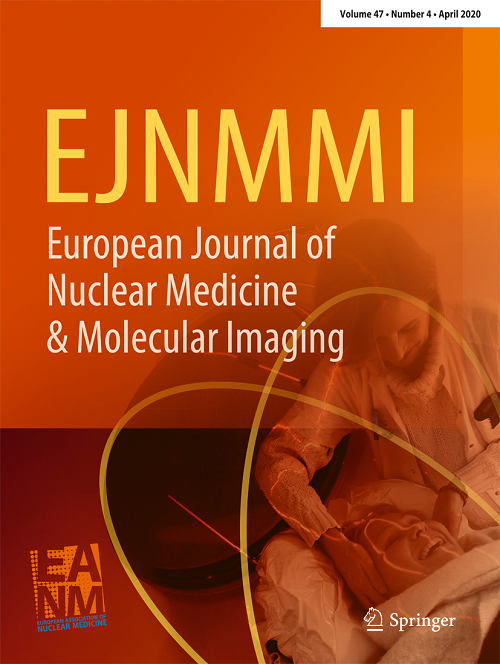Texture analysis of [18F]FDG PET/CT may stratify risk in stage II colorectal cancer - discovery findings.
IF 7.6
1区 医学
Q1 RADIOLOGY, NUCLEAR MEDICINE & MEDICAL IMAGING
European Journal of Nuclear Medicine and Molecular Imaging
Pub Date : 2025-10-06
DOI:10.1007/s00259-025-07568-6
引用次数: 0
Abstract
RATIONALE It is challenging to identify which patients with Stage II colorectal cancer (T3N0M0 and T4N0M0) are at high risk of recurrence and might benefit from additional therapies. This preliminary study examines whether multiparametric [18F]FDG PET/CT is superior to T-stage in predicting overall survival in this patient group. MATERIALS AND METHODS This multicentre, prospective observational study included 66 patients (41 male, 25 female, mean age 69.1 ± 10.3yrs) with biopsy-proven Stage II colorectal cancer who underwent [18F]FDG PET/CT prior to resection. Kaplan-Meier analysis was performed on PET and image texture parameters and clinico-histopathological markers to identify associations with survival. P-values were adjusted using the Benjamini-Hochberg procedure, and the most statistically significant radiomic parameters underwent 3-fold cross-validation. Multivariate Cox regression analysis was used to determine independence of prognostic markers. RESULTS 49 patients survived the follow up period, with a mean overall survival of 88.4 (± 42.3 months). Univariate analysis showed no significant survival association with clinical variables such as patient sex (p = 0.295), age (p = 0.085), tumour side (p = 0.662), location (p = 0.848) or volume (p = 0.782), or high-risk histopathological metrics including low number lymph node sampling (p = 0.363), perineural, lymphovascular or extramural tumour invasion (p = 0.196), poor tumour differentiation (p = 0.372), and tumour perforation (p = 0.475). No significant survival difference was observed between T3 and T4-stages (p = 0.748). An increased mortality risk was observed for patients with a pixel mean intensity < 20.390 on CT texture (coarse texture scale), HR: 3.40 (1.36-8.49); p = 0.005, and where SUVmax ≥ 25.560 g/mL on [18F]FDG PET/CT, HR: 3.45 (1.31-9.12); p = 0.008. These parameters remained significant after 3-fold cross validation and were independent predictors of survival after Multivariate Cox regression analysis. A higher mortality risk was indicated when the parameters were combined (5 of 66 patients), hazard ratio: 5.44 (1.75-16.91); p = 0.001. CONCLUSION Multiparametric [18F]FDG PET/CT can potentially provide prognostic markers for patients with stage II colorectal cancer with superior risk stratification compared to T-stage.[18F]FDG PET/CT的结构分析可能对II期结直肠癌的风险进行分层。
确定哪些II期结直肠癌(T3N0M0和T4N0M0)患者有高复发风险,并可能从额外的治疗中获益是具有挑战性的。本初步研究探讨了多参数[18F]FDG PET/CT在预测该患者组的总生存率方面是否优于t分期。材料与方法本研究是一项多中心前瞻性观察性研究,纳入66例经活检证实的II期结直肠癌患者(男性41例,女性25例,平均年龄69.1±10.3岁),并在手术前行FDG PET/CT检查[18F]。对PET和图像纹理参数以及临床组织病理学标志物进行Kaplan-Meier分析,以确定与生存的关系。p值采用Benjamini-Hochberg程序调整,最具统计学意义的放射学参数进行3次交叉验证。采用多因素Cox回归分析确定预后指标的独立性。结果49例患者在随访期间存活,平均总生存期88.4(±42.3个月)。单因素分析显示,生存率与患者性别(p = 0.295)、年龄(p = 0.085)、肿瘤部位(p = 0.662)、位置(p = 0.848)或体积(p = 0.782)等临床变量,或高危组织病理学指标(包括淋巴结取样数少(p = 0.363)、神经周围、淋巴血管或外膜肿瘤侵袭(p = 0.196)、肿瘤分化差(p = 0.372)和肿瘤穿孔(p = 0.475)无显著相关性。T3期与t4期生存率无显著差异(p = 0.748)。CT纹理(粗纹理尺度)像素平均强度< 20.390的患者死亡风险增加,HR: 3.40 (1.36-8.49);p = 0.005,当SUVmax≥25.560 g/mL时,[18F]FDG PET/CT的风险比为3.45 (1.31-9.12);p = 0.008。这些参数在3倍交叉验证后仍然显著,并在多变量Cox回归分析后成为独立的生存预测因子。当这些参数联合使用时,死亡风险较高(66例中有5例),风险比为5.44 (1.75-16.91);p = 0.001。结论多参数FDG PET/CT可为风险分层优于t期的II期结直肠癌患者提供潜在的预后指标。
本文章由计算机程序翻译,如有差异,请以英文原文为准。
求助全文
约1分钟内获得全文
求助全文
来源期刊
CiteScore
15.60
自引率
9.90%
发文量
392
审稿时长
3 months
期刊介绍:
The European Journal of Nuclear Medicine and Molecular Imaging serves as a platform for the exchange of clinical and scientific information within nuclear medicine and related professions. It welcomes international submissions from professionals involved in the functional, metabolic, and molecular investigation of diseases. The journal's coverage spans physics, dosimetry, radiation biology, radiochemistry, and pharmacy, providing high-quality peer review by experts in the field. Known for highly cited and downloaded articles, it ensures global visibility for research work and is part of the EJNMMI journal family.

 求助内容:
求助内容: 应助结果提醒方式:
应助结果提醒方式:


